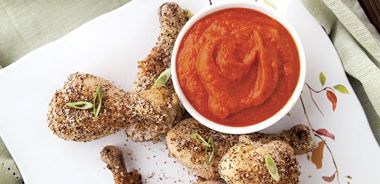Rooibos Chai Rubbed Chicken with Roasted Red Pepper Sauce

Who says comfort food can’t be healthy? These crisp-baked drumsticks are teeming with nutrients and the exotic spicy taste of rooibos chai. While not a “true” tea from the Camellia sinensis plant, rooibos is also, like true tea, abundant in disease-fighting polyphenols. Not surprisingly, preliminary animal studies suggest rooibos may play a role in staving off cancer.
Chicken
1 Tbsp (15 mL) rooibos chai loose-leaf tea
1/4 cup (60 mL) fine bread crumbs (you could also use cornmeal or cracker crumbs)
1/4 tsp (1 mL) sea salt
1/4 tsp (1 mL) cardamom
8 small organic chicken drumsticks, skin removed
Ground black pepper, to taste
Sauce
3 small red peppers
2 tsp (10 mL) camelina or extra-virgin olive oil
1 small onion, peeled and minced
2 very small garlic cloves, peeled and minced
2/3 cup (160 mL) tomato juice
1/3 cup (80 mL) reduced-sodium vegetable or chicken stock
Pinch of coconut palm sugar
Paprika, to taste
Ground black pepper, to taste
For chicken, preheat oven to 375 F (190 C).
Grind rooibos chai in spice grinder until very fine. Add to bread crumbs in small bowl along with sea salt and cardamom, and mix well. Spread bread crumb mixture on large plate. Roll drumsticks in mixture to coat evenly, pressing with fingers to ensure mixture adheres to chicken. Season with black pepper to taste.
Transfer drumsticks to seasoned cast iron pan and bake for 30 minutes, or until golden and cooked through.
While chicken is cooking, prepare sauce. Roast red peppers until slightly charred. Place in paper bag to cool and then remove skin and seeds, and chop into uniform chunks. Set aside.
Heat oil in large, well seasoned skillet. Add onion and cook until soft. Add garlic and cook for 1 minute more. Pour tomato juice and stock into pan, and add coconut palm sugar. Simmer for 5 minutes. Add roasted red peppers and simmer covered, another 5 to 10 minutes. Remove from heat and allow to cool slightly.
Place mixture in food processor and blend until smooth. Return to pan to heat through. Season with paprika and ground black pepper to taste.
Place generous amount of sauce on 4 plates and top with chicken drumsticks. Serve with basmati rice or freekeh.
Serves 4.
Each serving contains: 178 calories; 18 g protein; 6 g total fat (1 g sat. fat, 0 g trans fat); 13 g carbohydrates (6 g sugars, 2 g fibre); 176 mg sodium
source: "Cooking With Tea", alive #368, June 2013




